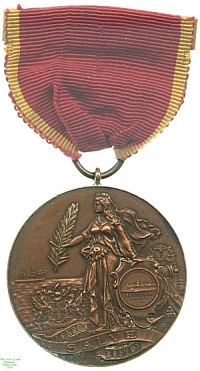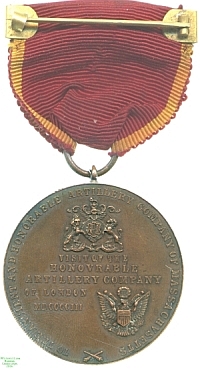Ancient & Honourable Artillery Company of Massachusetts Medal for the Visit of the Honourable Artillery Company of London, awarded to Sgt. Tptr W. J. Waterlow, 1903

Obverse, a female figure in Classical dress and veil facing left, holding a palm frond and resting her hand on a parchment on which a central boss displays Boston from the sea, with a marginal inscription and the central legend BOSTONIA. She stands amid the rooftops of a shoreline city with a steamship under way at sea to the left; the Boston city arms are displayed below the ship, and below all is the legend "LONDON / SALVE / BOSTON" on a banner
|

Reverse, inscription between the two Companies' coats of arms
|
<- Previous | Next ->
Back to gallery page
Ancient & Hon. Artillery Co. of Massachusetts Medal for the Hon. Artillery Co. of London, 1903
Although this medal was awarded by the Ancient and Honourable Artillery Co. of Massachusetts, it relates more to the organisation to which it was awarded, the Honourable Artillery Co. of London, which is more fully described elsewhere. The Massachusetts Company was formed after the emigration of a number of the HAC's members to America in the 1620s and 1630s, but relations became distant soon afterwards, and after the Anglo-American `War of 1812' were broken off completely.
Only in 1851, when members of the AHAC visited the Great Exhibition in London, were the two branches renewed in contact, and thereafter a slow exchange of visits began. In 1903 the London branch crossed the Atlantic to meet their American fellows, and this medal was created for the occasion.
This example was awarded to Sergeant Trumpeter W. J. Waterlow, a stalwart member of the HAC and its veteran association the Old Gunners' Club. It is one of three of his medals that are now in the Watson Collection; the others follow. The medals are not attached to each other so although the Watson Collection catalogue considers them as Group 5 they have been treated separately here. Nonetheless, it was as a group that Lester Watson purchased them at some point before 1928; they had all previously formed part of the Payne Collection.

